BUGEN 5930: Reflective Journal on Business, Society, and Planet
VerifiedAdded on 2022/10/12
|7
|1301
|209
Journal and Reflective Writing
AI Summary
This reflective journal explores the themes of sustainability in business, including the Triple Bottom Line, the Six Forms of Capital, and the six phases of business approaches to sustainability. It reflects on the relevance and implications of these issues for the business sector, drawing from course materials and discussions. The journal includes examples of businesses, such as Unilever, that are successfully engaging in sustainable practices, highlighting the importance of integrating sustainability into core business strategies to achieve long-term efficiencies and competitiveness. The student reflects on the importance of energy efficiency, sustainable principles, and corporate social responsibility.
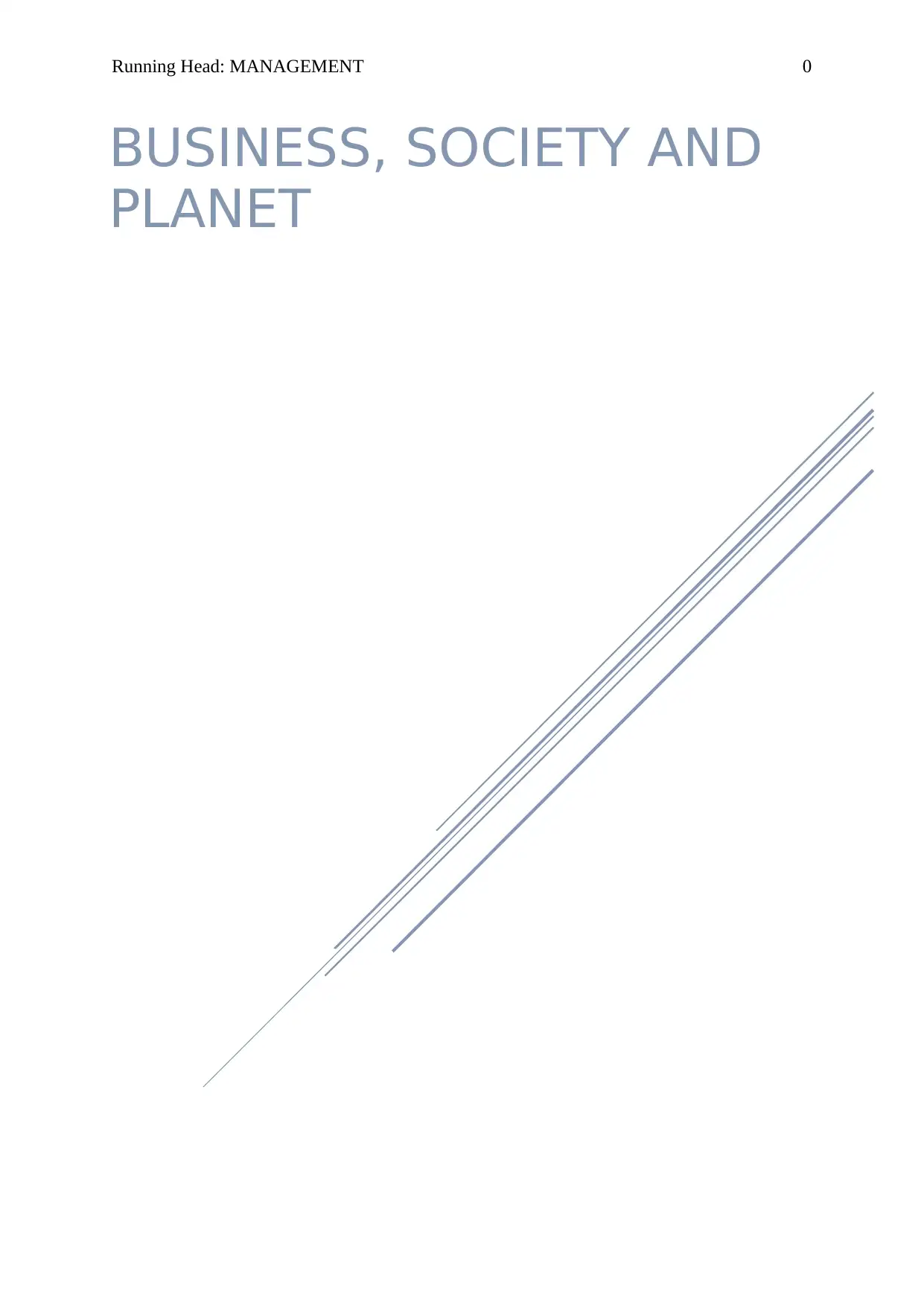
Running Head: MANAGEMENT 0
BUSINESS, SOCIETY AND
PLANET
BUSINESS, SOCIETY AND
PLANET
Paraphrase This Document
Need a fresh take? Get an instant paraphrase of this document with our AI Paraphraser
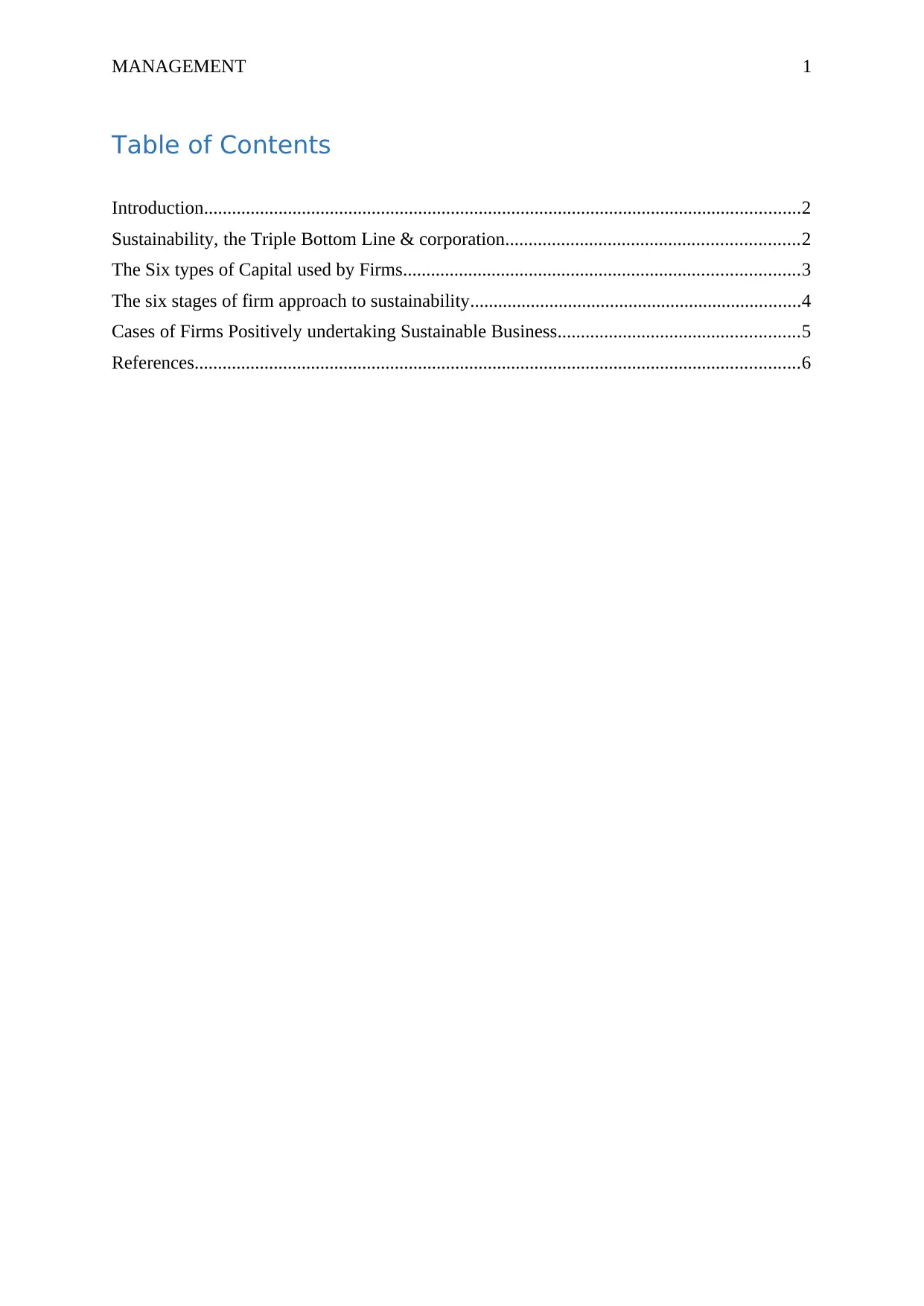
MANAGEMENT 1
Table of Contents
Introduction................................................................................................................................2
Sustainability, the Triple Bottom Line & corporation...............................................................2
The Six types of Capital used by Firms.....................................................................................3
The six stages of firm approach to sustainability.......................................................................4
Cases of Firms Positively undertaking Sustainable Business....................................................5
References..................................................................................................................................6
Table of Contents
Introduction................................................................................................................................2
Sustainability, the Triple Bottom Line & corporation...............................................................2
The Six types of Capital used by Firms.....................................................................................3
The six stages of firm approach to sustainability.......................................................................4
Cases of Firms Positively undertaking Sustainable Business....................................................5
References..................................................................................................................................6
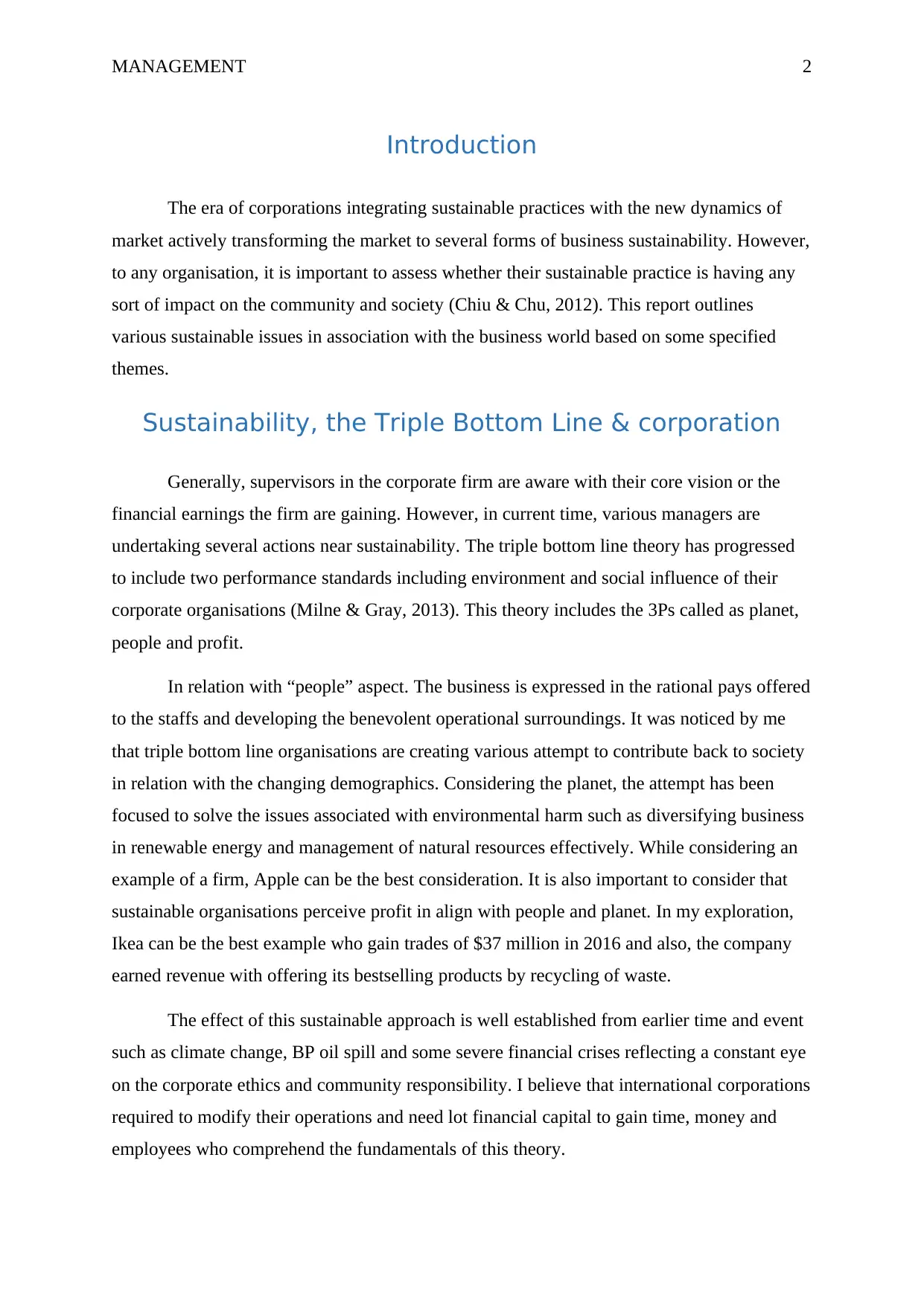
MANAGEMENT 2
Introduction
The era of corporations integrating sustainable practices with the new dynamics of
market actively transforming the market to several forms of business sustainability. However,
to any organisation, it is important to assess whether their sustainable practice is having any
sort of impact on the community and society (Chiu & Chu, 2012). This report outlines
various sustainable issues in association with the business world based on some specified
themes.
Sustainability, the Triple Bottom Line & corporation
Generally, supervisors in the corporate firm are aware with their core vision or the
financial earnings the firm are gaining. However, in current time, various managers are
undertaking several actions near sustainability. The triple bottom line theory has progressed
to include two performance standards including environment and social influence of their
corporate organisations (Milne & Gray, 2013). This theory includes the 3Ps called as planet,
people and profit.
In relation with “people” aspect. The business is expressed in the rational pays offered
to the staffs and developing the benevolent operational surroundings. It was noticed by me
that triple bottom line organisations are creating various attempt to contribute back to society
in relation with the changing demographics. Considering the planet, the attempt has been
focused to solve the issues associated with environmental harm such as diversifying business
in renewable energy and management of natural resources effectively. While considering an
example of a firm, Apple can be the best consideration. It is also important to consider that
sustainable organisations perceive profit in align with people and planet. In my exploration,
Ikea can be the best example who gain trades of $37 million in 2016 and also, the company
earned revenue with offering its bestselling products by recycling of waste.
The effect of this sustainable approach is well established from earlier time and event
such as climate change, BP oil spill and some severe financial crises reflecting a constant eye
on the corporate ethics and community responsibility. I believe that international corporations
required to modify their operations and need lot financial capital to gain time, money and
employees who comprehend the fundamentals of this theory.
Introduction
The era of corporations integrating sustainable practices with the new dynamics of
market actively transforming the market to several forms of business sustainability. However,
to any organisation, it is important to assess whether their sustainable practice is having any
sort of impact on the community and society (Chiu & Chu, 2012). This report outlines
various sustainable issues in association with the business world based on some specified
themes.
Sustainability, the Triple Bottom Line & corporation
Generally, supervisors in the corporate firm are aware with their core vision or the
financial earnings the firm are gaining. However, in current time, various managers are
undertaking several actions near sustainability. The triple bottom line theory has progressed
to include two performance standards including environment and social influence of their
corporate organisations (Milne & Gray, 2013). This theory includes the 3Ps called as planet,
people and profit.
In relation with “people” aspect. The business is expressed in the rational pays offered
to the staffs and developing the benevolent operational surroundings. It was noticed by me
that triple bottom line organisations are creating various attempt to contribute back to society
in relation with the changing demographics. Considering the planet, the attempt has been
focused to solve the issues associated with environmental harm such as diversifying business
in renewable energy and management of natural resources effectively. While considering an
example of a firm, Apple can be the best consideration. It is also important to consider that
sustainable organisations perceive profit in align with people and planet. In my exploration,
Ikea can be the best example who gain trades of $37 million in 2016 and also, the company
earned revenue with offering its bestselling products by recycling of waste.
The effect of this sustainable approach is well established from earlier time and event
such as climate change, BP oil spill and some severe financial crises reflecting a constant eye
on the corporate ethics and community responsibility. I believe that international corporations
required to modify their operations and need lot financial capital to gain time, money and
employees who comprehend the fundamentals of this theory.
⊘ This is a preview!⊘
Do you want full access?
Subscribe today to unlock all pages.

Trusted by 1+ million students worldwide
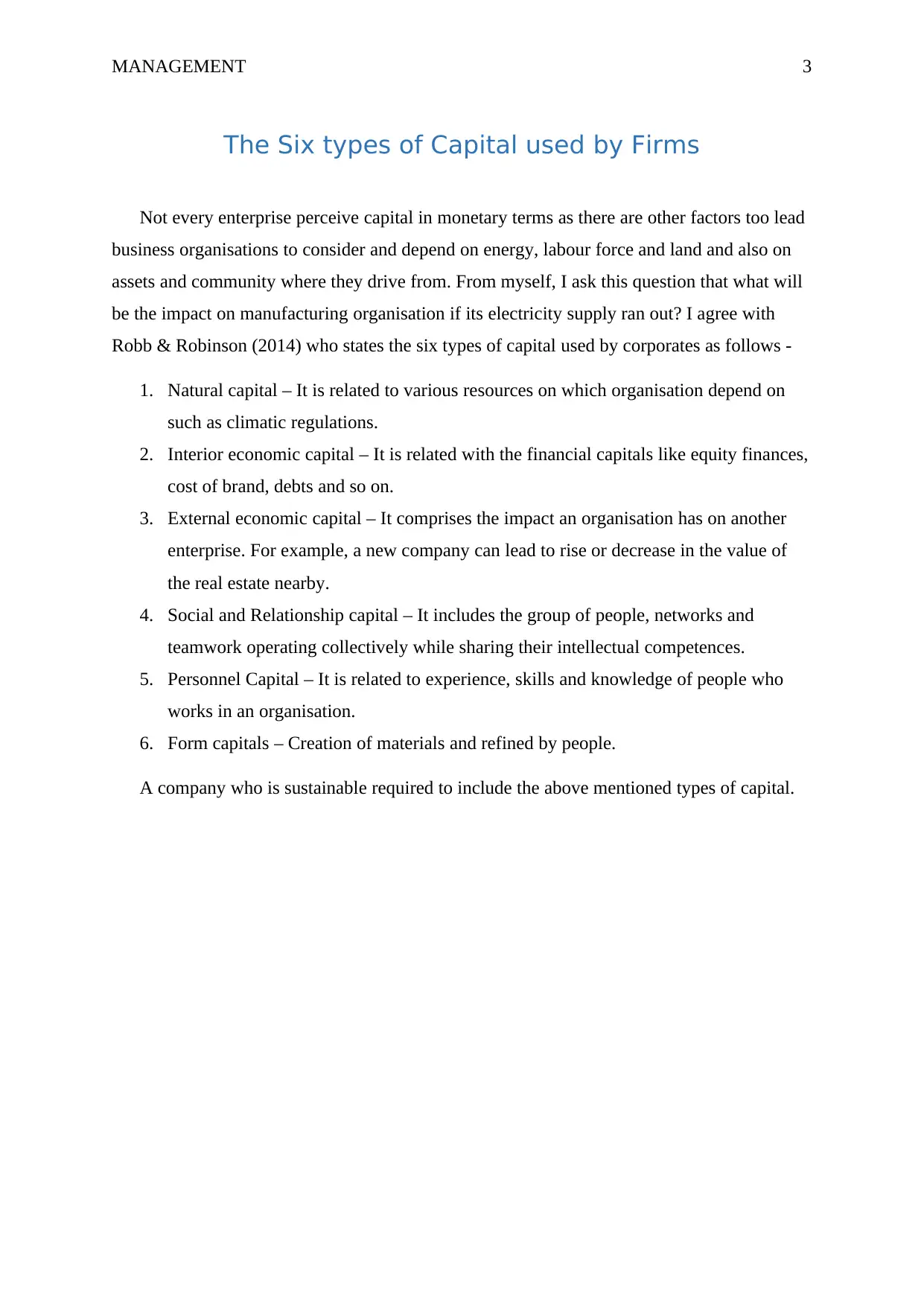
MANAGEMENT 3
The Six types of Capital used by Firms
Not every enterprise perceive capital in monetary terms as there are other factors too lead
business organisations to consider and depend on energy, labour force and land and also on
assets and community where they drive from. From myself, I ask this question that what will
be the impact on manufacturing organisation if its electricity supply ran out? I agree with
Robb & Robinson (2014) who states the six types of capital used by corporates as follows -
1. Natural capital – It is related to various resources on which organisation depend on
such as climatic regulations.
2. Interior economic capital – It is related with the financial capitals like equity finances,
cost of brand, debts and so on.
3. External economic capital – It comprises the impact an organisation has on another
enterprise. For example, a new company can lead to rise or decrease in the value of
the real estate nearby.
4. Social and Relationship capital – It includes the group of people, networks and
teamwork operating collectively while sharing their intellectual competences.
5. Personnel Capital – It is related to experience, skills and knowledge of people who
works in an organisation.
6. Form capitals – Creation of materials and refined by people.
A company who is sustainable required to include the above mentioned types of capital.
The Six types of Capital used by Firms
Not every enterprise perceive capital in monetary terms as there are other factors too lead
business organisations to consider and depend on energy, labour force and land and also on
assets and community where they drive from. From myself, I ask this question that what will
be the impact on manufacturing organisation if its electricity supply ran out? I agree with
Robb & Robinson (2014) who states the six types of capital used by corporates as follows -
1. Natural capital – It is related to various resources on which organisation depend on
such as climatic regulations.
2. Interior economic capital – It is related with the financial capitals like equity finances,
cost of brand, debts and so on.
3. External economic capital – It comprises the impact an organisation has on another
enterprise. For example, a new company can lead to rise or decrease in the value of
the real estate nearby.
4. Social and Relationship capital – It includes the group of people, networks and
teamwork operating collectively while sharing their intellectual competences.
5. Personnel Capital – It is related to experience, skills and knowledge of people who
works in an organisation.
6. Form capitals – Creation of materials and refined by people.
A company who is sustainable required to include the above mentioned types of capital.
Paraphrase This Document
Need a fresh take? Get an instant paraphrase of this document with our AI Paraphraser

MANAGEMENT 4
The six stages of firm approach to sustainability
Phase Organisation Attributes Procurement Attributes
Rejection This step displays the independent
exploitation of individual, natural
environment and subcontractor.
Cost is only be included while
considering purchasing safety and
health while acquisition is
cheapest. In relation with
purchasing decisions, this phase
does not include environment for
the goods.
Non-
Responsiveness
There is ignorance of community and
environmental issues.
Sustainability focused actions are
perceived as an unnecessary cost.
Compliance It emphases on reduction of risks from
failing to fulfil least possible standards.
It focused in on the sustainability
problems that have the highest legal
risk.
It is emphasis on jurisdictive
reaction and contractual needs.
Efficiency It shows a bigger awareness of
sustainability practices and the
concentration is on proficiency and the
subsequent cost-saving advantages to
the business.
Assimilate sustainability in waste
products and procurement
decisions.
Strategic
proactivity
Here, sustainability come to be part of
the core strategy and the active
Employees are trained with
adequate sustainable standards
The six stages of firm approach to sustainability
Phase Organisation Attributes Procurement Attributes
Rejection This step displays the independent
exploitation of individual, natural
environment and subcontractor.
Cost is only be included while
considering purchasing safety and
health while acquisition is
cheapest. In relation with
purchasing decisions, this phase
does not include environment for
the goods.
Non-
Responsiveness
There is ignorance of community and
environmental issues.
Sustainability focused actions are
perceived as an unnecessary cost.
Compliance It emphases on reduction of risks from
failing to fulfil least possible standards.
It focused in on the sustainability
problems that have the highest legal
risk.
It is emphasis on jurisdictive
reaction and contractual needs.
Efficiency It shows a bigger awareness of
sustainability practices and the
concentration is on proficiency and the
subsequent cost-saving advantages to
the business.
Assimilate sustainability in waste
products and procurement
decisions.
Strategic
proactivity
Here, sustainability come to be part of
the core strategy and the active
Employees are trained with
adequate sustainable standards

MANAGEMENT 5
environmental schemes assisting
sustainable ecology are tracked.
and suppliers are encouraged by
corporate in relation with
sustainable line.
The Sustainable
Corporation
Here, the corporation undertakes
human welfare, community equity and
encourage ecological sustainability
with compliance to all sustainable
standards.
Organisation behaviour is
determined by sustainable
procurements and it is integrated
into process of procurement.
Cases of Firms Positively undertaking Sustainable
Business
Many organisations working on both large scale and small scale are found challenging
adopting sustainable standards as they are trying to becoming more profitable and efficiency
while not considering corporate social responsibility (CSR) targets (Davies, 2016). However,
Unilever is one of the multinational company that is positively including this thing in their
culture. This can be seen by their various practices such as purpose of doubling the income
while decreasing its environmental footprints and in 2010, the company also introduced
Anglo-Dutch Conglomerate's Sustainable Living Plan. Unilever also saves lot of costs by
reserving ion the energy, time and waste in the process of manufacturing. 2008 eco
production also help them to save more than €600 million (Moumita & Zaman, 2013).
Through these sustainable approaches, the company operating costs has been considerably
reduced while undertaking more efficient activities.
To conclude, the greater importance the corporate places on energy efficiency and
sustainable principles, it helps them to put efficiencies and competitiveness in their business
for a longer period of time.
environmental schemes assisting
sustainable ecology are tracked.
and suppliers are encouraged by
corporate in relation with
sustainable line.
The Sustainable
Corporation
Here, the corporation undertakes
human welfare, community equity and
encourage ecological sustainability
with compliance to all sustainable
standards.
Organisation behaviour is
determined by sustainable
procurements and it is integrated
into process of procurement.
Cases of Firms Positively undertaking Sustainable
Business
Many organisations working on both large scale and small scale are found challenging
adopting sustainable standards as they are trying to becoming more profitable and efficiency
while not considering corporate social responsibility (CSR) targets (Davies, 2016). However,
Unilever is one of the multinational company that is positively including this thing in their
culture. This can be seen by their various practices such as purpose of doubling the income
while decreasing its environmental footprints and in 2010, the company also introduced
Anglo-Dutch Conglomerate's Sustainable Living Plan. Unilever also saves lot of costs by
reserving ion the energy, time and waste in the process of manufacturing. 2008 eco
production also help them to save more than €600 million (Moumita & Zaman, 2013).
Through these sustainable approaches, the company operating costs has been considerably
reduced while undertaking more efficient activities.
To conclude, the greater importance the corporate places on energy efficiency and
sustainable principles, it helps them to put efficiencies and competitiveness in their business
for a longer period of time.
⊘ This is a preview!⊘
Do you want full access?
Subscribe today to unlock all pages.

Trusted by 1+ million students worldwide
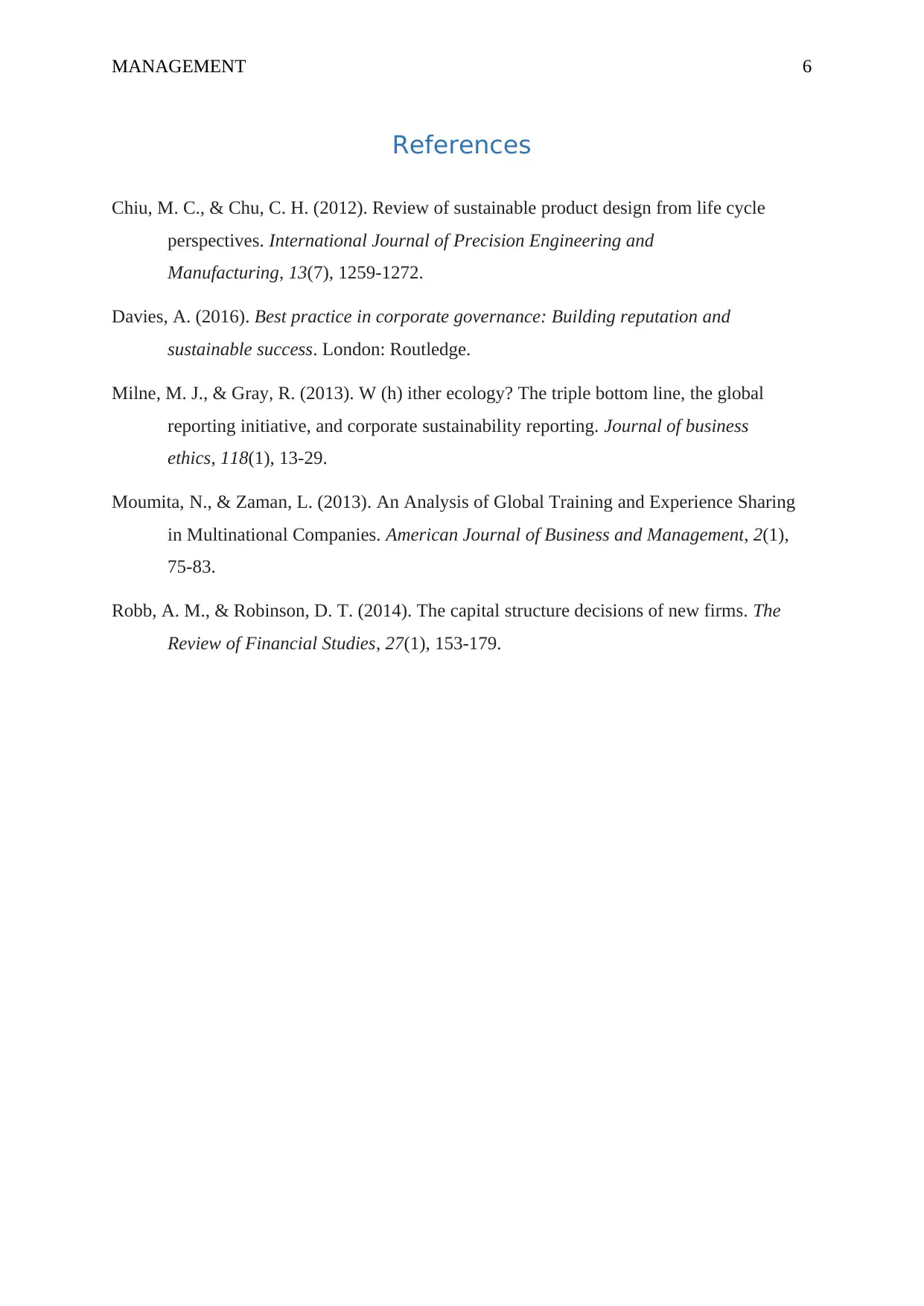
MANAGEMENT 6
References
Chiu, M. C., & Chu, C. H. (2012). Review of sustainable product design from life cycle
perspectives. International Journal of Precision Engineering and
Manufacturing, 13(7), 1259-1272.
Davies, A. (2016). Best practice in corporate governance: Building reputation and
sustainable success. London: Routledge.
Milne, M. J., & Gray, R. (2013). W (h) ither ecology? The triple bottom line, the global
reporting initiative, and corporate sustainability reporting. Journal of business
ethics, 118(1), 13-29.
Moumita, N., & Zaman, L. (2013). An Analysis of Global Training and Experience Sharing
in Multinational Companies. American Journal of Business and Management, 2(1),
75-83.
Robb, A. M., & Robinson, D. T. (2014). The capital structure decisions of new firms. The
Review of Financial Studies, 27(1), 153-179.
References
Chiu, M. C., & Chu, C. H. (2012). Review of sustainable product design from life cycle
perspectives. International Journal of Precision Engineering and
Manufacturing, 13(7), 1259-1272.
Davies, A. (2016). Best practice in corporate governance: Building reputation and
sustainable success. London: Routledge.
Milne, M. J., & Gray, R. (2013). W (h) ither ecology? The triple bottom line, the global
reporting initiative, and corporate sustainability reporting. Journal of business
ethics, 118(1), 13-29.
Moumita, N., & Zaman, L. (2013). An Analysis of Global Training and Experience Sharing
in Multinational Companies. American Journal of Business and Management, 2(1),
75-83.
Robb, A. M., & Robinson, D. T. (2014). The capital structure decisions of new firms. The
Review of Financial Studies, 27(1), 153-179.
1 out of 7
Related Documents
Your All-in-One AI-Powered Toolkit for Academic Success.
+13062052269
info@desklib.com
Available 24*7 on WhatsApp / Email
![[object Object]](/_next/static/media/star-bottom.7253800d.svg)
Unlock your academic potential
Copyright © 2020–2025 A2Z Services. All Rights Reserved. Developed and managed by ZUCOL.




